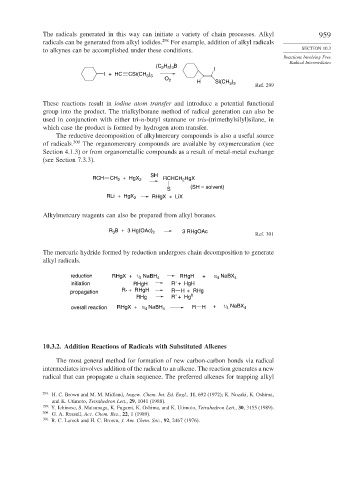Page 983 - Advanced Organic Chemistry Part B - Reactions & Synthesis
P. 983
The radicals generated in this way can initiate a variety of chain processes. Alkyl 959
radicals can be generated from alkyl iodides. 298 For example, addition of alkyl radicals
to alkynes can be accomplished under these conditions. SECTION 10.3
Reactions Involving Free
Radical Intermediates
(C 2 H 5 ) 3 B
I
I + HC CSi(CH )
3 3
O 2 H Si(CH )
3 3
Ref. 299
These reactions result in iodine atom transfer and introduce a potential functional
group into the product. The trialkylborane method of radical generation can also be
used in conjunction with either tri-n-butyl stannane or tris-(trimethylsilyl)silane, in
which case the product is formed by hydrogen atom transfer.
The reductive decomposition of alkylmercury compounds is also a useful source
of radicals. 300 The organomercury compounds are available by oxymercuration (see
Section 4.1.3) or from organometallic compounds as a result of metal-metal exchange
(see Section 7.3.3).
SH
RCH CH + HgX 2 RCHCH HgX
2
2
S (SH = solvent)
RLi + HgX 2 RHgX + LiX
Alkylmercury reagents can also be prepared from alkyl boranes.
B + 3 Hg(OAc)
R 3 2 3 RHgOAc
Ref. 301
The mercuric hydride formed by reduction undergoes chain decomposition to generate
alkyl radicals.
reduction RHgX + 1 / 4 NaBH 4 RHgH + 1/ 4 NaBX 4
.
initiation RHgH R + HgH
.
R + RHgH
propagation R . H + RHg
RHg R + Hg 0
overall reaction RHgX + 1/ 4 NaBH 4 R H + 1/ 4 NaBX 4
10.3.2. Addition Reactions of Radicals with Substituted Alkenes
The most general method for formation of new carbon-carbon bonds via radical
intermediates involves addition of the radical to an alkene. The reaction generates a new
radical that can propagate a chain sequence. The preferred alkenes for trapping alkyl
298 H. C. Brown and M. M. Midland, Angew. Chem. Int. Ed. Engl., 11, 692 (1972); K. Nozaki, K. Oshima,
and K. Utimoto, Tetrahedron Lett., 29, 1041 (1988).
299
Y. Ichinose, S. Matsunaga, K. Fugami, K. Oshima, and K. Utimoto, Tetrahedron Lett., 30, 3155 (1989).
300 G. A. Russell, Acc. Chem. Res., 22, 1 (1989).
301
R. C. Larock and H. C. Brown, J. Am. Chem. Soc., 92, 2467 (1976).

